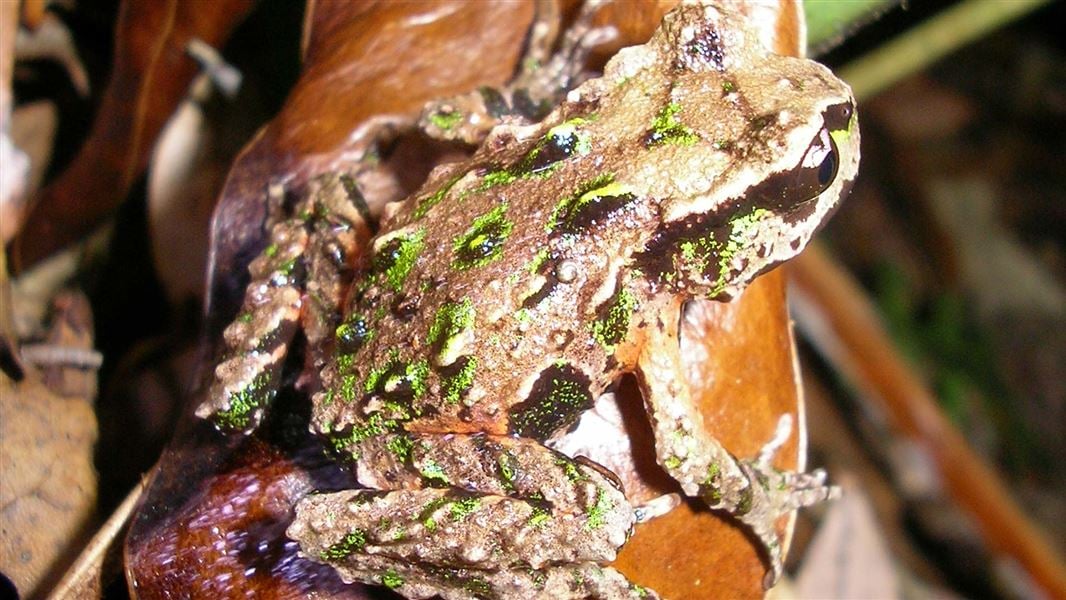
Introduction
Help is on the way for the endangered Archey's frogs.Date: 20 July 2017
Archey’s frogs are modern-day dinosaurs. Almost unchanged from its 150 million-year old fossilised relatives, these little battlers are among the world’s oldest frogs and in desperate need of help.
And help is now on the way thanks to the Battle for our Birds campaign.
Whareorino 2017 is a Battle for our Frogs, which will protect Archey’s and Hochstetter’s frogs, long tail bats and important mountains-to-sea forest catchments.
Partners DOC and Waikato Regional Council aim to improve biodiversity, maintain catchment health and enhance production. Adopting best practice and working together extends the benefits of pest control and reduces possum reinvasion.
Amongst the 30,000-ha operation area is the last stronghold for Archey’s frogs.
Archey’s history
The Whareorino range lies in the Western King Country and holds key populations of Archey’s frog (Leiopelma archeyi), and cousin Hochstetter’s frog (Leiopelma hochstetteri) and many other special plants and animals.
Archey’s are the smallest of New Zealand’s four species of native frogs, and this nocturnal master of camouflage was first described as a separate species in 1942.
Mottled colours of red, green and brown make up the colour of the Archey’s skin; patterns so distinctive and different DOC uses these to individually identify the frogs in a monitoring programme that has been conducted for well over a decade.
Archey’s frogs make a tasty meal for rats. Researchers have found dead frogs with rat bite marks, and frogs in the stomachs of dead rats.
Other potential predators to Archey’s are pigs, stoats, hedgehogs, possums, cats and introduced frogs.
To fight the decline and give Archey’s a sporting chance, a combination of intensive ground pest control and an aerial 1080 operation will be used in the battle. Controlling rats and possums before the breeding season increases the breeding success of frogs, bats, and native birds.
For Archey’s, a 1080 operation will reduce rat numbers over a short time frame and allow a break for the ground-based control until rat numbers increase again.
Pest control plans
A range of pest control methods will be used including traps and toxins, depending on the specific locations, and landowner preferences. For control on private land, control methods have been agreed with the landowner or occupier.
For larger tracts of land, aerial application of 1080 baits is the most cost-effective predator control method and the only viable method in rugged terrain. Aerial 1080 pest control will target rats and possums and stoats will be eliminated through eating poisoned rodent carcasses.
Aerial operations will begin with a pre-feed of non-toxic baits to encourage rats and possums to eat the 1080 baits applied at a later date.
The pesticides used for aerial predator control are poisonous to humans and domestic animals. Poisoning can occur through eating cereal baits or poisoned animals.
Dogs are highly susceptible to 1080. The risk to dogs from poisoned carcasses will remain until they have completely rotted away.
These risks can be eliminated by following these simple rules:
- do not touch bait
- watch children at all times
- do not eat animals from this area
- poison baits or carcasses are deadly to dogs.
Observe these rules whenever you see warning signs about pesticides. When signs are removed, this means you can resume normal activities in the area.
The rat control programme at Whareorino Forest is a nationally important native frog conservation project. The pest control outcomes at Whareorino represent a model for Archey’s frog conservation in mainland New Zealand. Whareorino is the closest we have to a mainland frog sanctuary in New Zealand.
Contact
Erana Stevens-Tulip, Senior Ranger (Community)
Mobile: +64 27 216 4265
Email: estevens@doc.govt.nz